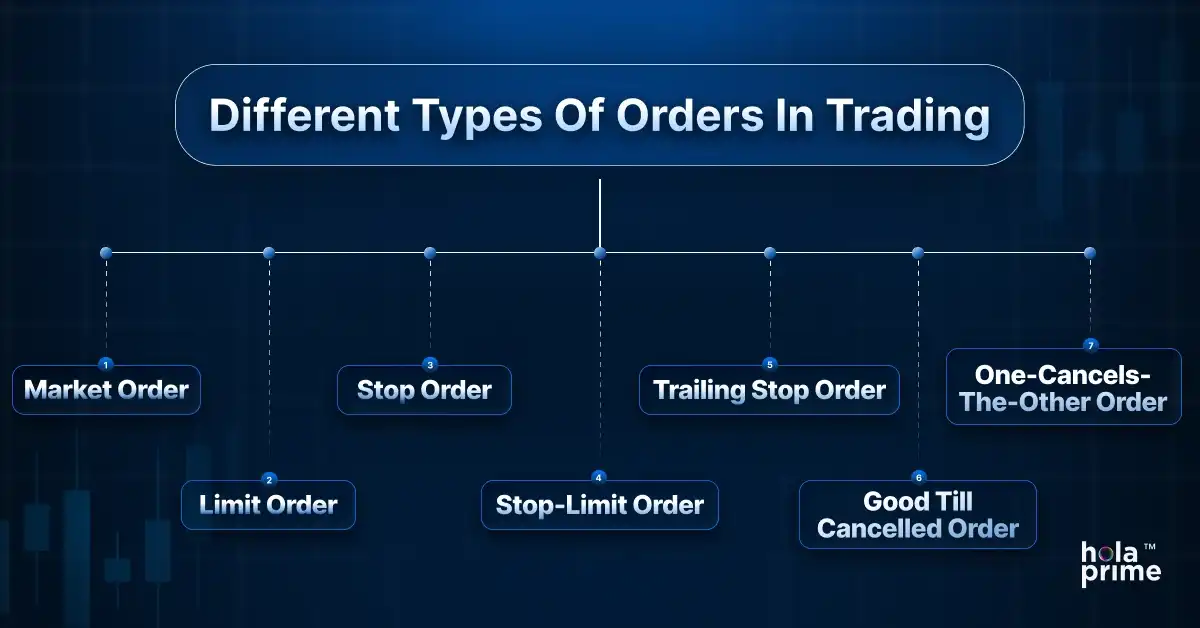Trading Order Types: Market order, Stop Order, Limit Orde
- Ankit Gupta
- August 12, 2025

Introduction:
Have you ever clicked “Buy” or “Sell” and immediately experienced the feeling of, “Maybe I should have waited?” If you are like most people, you have felt this, and you are not alone. This is one of the largest problems with trading, and it is a problem you never have to deal with at all, if you understand different order types. You don’t have to be glued to your screen to trade and find the perfect time to execute. This is why different order types exist for you; they do the heavy lifting of your execution so that you can focus on your trading strategy.
Orders act as instructions, instructions to your platform telling it when and when to execute a trade on your behalf. Regardless of being a novice to trading, or if you have been actively trading for a long time, research and understanding different order types can help you avoid mistakes worth hundreds of dollars, maybe even more, and better risk manage
What is an Order in Trading?
An order is simply an instruction to execute a trade; it can either be a buy trade or a sell trade. Further, the conditions on which you want an order to be executed, distinguishes one order types from another.
Without using proper order types, you’d have to watch price movements constantly, ready to click manually at every opportunity. That’s stressful and prone to errors. With the right order, you set conditions ahead of time, letting the market work for you while you focus on planning your next move.
Different Types of Orders in Trading:

1. Market Order:
A market order is the simplest type. It buys or sells immediately at the best available price.
When to use: When speed matters more than price, and you want immediate execution of your order.
Example: Imagine EUR/USD is trading at 1.1578, and you want to buy it right now, then you would place a market order, as it executes instantly at or near that price.
Pros: Fast order execution.
Cons: You might experience slippage in fast markets.
2. Limit Order:
A limit order allows you to set the price you would like to buy or sell. The trade will only execute if the market touches your price or better.
When to use: If you want to open a buy trade at the limit price or lower or open a sell trade at the limit price or higher.
Example: Gold is at $2,050, and you want to buy at $2,000. Place a buy limit order at $2,000, and wait.
Pros: Better control of entry/exit price.
Cons: The trade may never get executed if the price doesn’t reach your level.
3. Stop Order:
A stop order triggers a market order once the price hits a specific level. It’s often used as a stop-loss or to catch breakouts.
Stop-Loss: Safeguards your account against larger losses by automatically closing a trade.
Stop Entry: Allows you to buy after the price breaks above resistance or sell after price drops below support.
Example: You open a buy trade of oil at $80 today and want to keep your loss limited to $75. You would then set a stop-loss order at $75. If oil falls to $75 it will sell automatically and you will be protect from large losses which would have been incurred without the stop loss.
Pros: Automatic risk management.
Cons: May execute at a worse price during high volatility.
4. Stop-Limit Order:
A stop-limit order combines a stop order and a limit order. Once the stop price is reached, it places a limit order instead of a market order.
When to use: If you want to enter a trade but avoid slippage.
Example: NAS100 is trading at 15,900. You believe a break above 16,000 means strength, but you don’t want to buy above 16,020. You set a stop at 16,000 with a limit of 16,020.
Pros: More control over execution price.
Cons: If the price jumps past your limit, you might miss the trade.
5. Trailing Stop Order:
A trailing stop order is like a stop-loss that moves with the market. It locks in profits while letting the trade run.
When to use: To ride trends without giving back gains.
Example: You open a buy trade of crude oil at $70 with a trailing stop of $2. If oil rises to $75, your stop moves from $68 to $73, locking in $3 profit if prices reverse.
Pros: Protects profits without manually adjusting stops.
Cons: Can be tricky in choppy markets as small swings may close your trade early.
6. Good Till Cancelled Order:
A GTC order is valid until you cancel or it gets filled. GTC orders are in effect until canceled, unlike day orders, which expire after the trading session is over. GTC orders will wait as long as it takes to get where you need it to be.
When to Use: For long-term setups.
Example: You want to open a buy trade of silver at $20 and it is not there yet. This could take weeks to get there. You simply enter a GTC limit order, and the order sits and waits until the price touches $20.
Pros: No need to re-enter orders day after day.
Cons: You could potentially forget about old orders and then trigger them later.
7. One-Cancels-the-Other Order:
An OCO order links two orders together. If one executes, the other automatically cancels.
When to use: For breakout trading in either direction.
Example: EUR/USD is in a tight range. You set a buy stop above and a sell stop below. Whichever direction it breaks, one order fills and the other is cancelled.
Pros: Great for volatility or uncertain direction.
Cons: Needs proper planning so you don’t overcommit.
Conclusion:
Think of these order types as tools that allow you to manage trades like a professional. Each order type is designed for a different purpose; you may wish to get into your trade as quickly as possible, you may want the entry levels to be exact, you may want to protect your capital, or you may want to try to automate profit taking. So now, when you trade next time, use your newly acquired knowledge about different order types and use the exact one based on your need.
FAQs: Types of Trading Orders
1. What is a trading order?
A trading order is the request you give either to enter or exit a trade. It can be as simple as a market order or you can also place conditional orders, which execute when the conditions you set are met.
2. What is a trade order type?
There are different types of orders you can place, such as market order, stop order, limit order, and more. A trade order type is determined by the conditions you set for that order and what motive it fulfills.
3. When should I use a market order?
You should use a market order when you want immediate execution of your order. When you place a market order, your order gets executed at the quote price or the nearest price available.
4. What are the most used 4 types of orders?
The four major types of orders are market orders, stop orders, limit orders, and stop-limit orders.
5. How to choose the trading order type?
You should choose the order type based on your motive for that particular order. If you want quick delivery of your order, use market order; if you want price precision of your order, use limit order; likewise, if you want to automatically execute a market order at a specific price, use stop order.
Disclaimer: All information provided on this site is for educational purposes only, related to trading in financial markets. It is not intended as financial advice, business or investment recommendation, or as an opportunity or recommendation to trade any investment instruments. Hola Prime only provides an educational environment to traders, including tools, materials and simulated trading platforms which have data feed provided by Liquidity Providers. The information on this site is not directed at residents in any country or jurisdiction where such distribution or use would be contrary to local laws or regulations.

